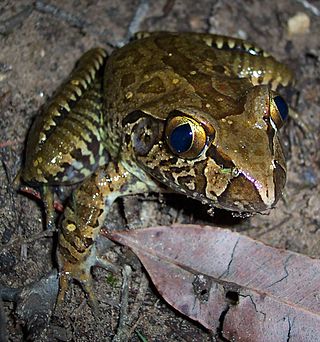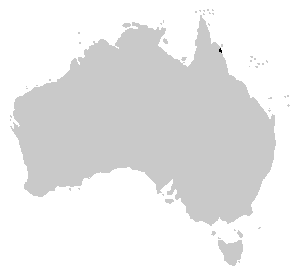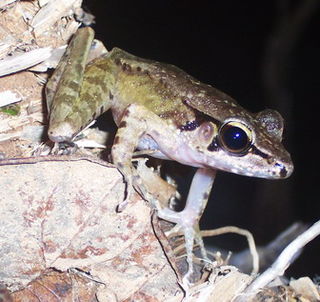
Conondale National Park is 130 km north of Brisbane in the Sunshine Coast Hinterland near the town of Conondale in the south east Queensland bioregion. The park covers an area of 35,648 hectares protecting large areas of subtropical rainforest, woodlands, wet and dry sclerophyll forest including Queensland's tallest tree. The park contains areas of regenerating forest which have been previously logged; areas of forest plantations also border the park. The park is currently managed by the Queensland Government under the Nature Conservation Act 1992.

Eungella National Park is a protected area in Queensland, Australia. It is on the Clarke Range at the end of the Pioneer Valley 80 km west of Mackay, and 858 km northwest of Brisbane. Eungella is noted for the national park which surrounds it. It is considered to be the longest continual stretch of sub-tropical rainforest in Australia. The original inhabitants are the Wirri people. The park is covered by dense rainforest and is known for its platypuses.

Threatened fauna of Australia are those species and subspecies of birds, fish, frogs, insects, mammals, molluscs, crustaceans and reptiles to be found in Australia that are in danger of becoming extinct. This list is the list proclaimed under the Australian federal Environment Protection and Biodiversity Conservation Act 1999. The classifications are based on those used by the World Conservation Union (IUCN), however IUCN and Australian rankings do differ. Each state and territory has its own legislation relating to environmental protection.

Taudactylus is a genus of frogs in the family Myobatrachidae. These frogs are endemic to rainforest areas of coastal eastern Australia, most of this genus inhabit fast flowing streams in highland area. Most members of this genus have suffered serious declines, in which the disease chytridiomycosis appears to have played a significant role: T. diurnus is believed to be extinct, while all others except T. liemi are listed as critically endangered by the IUCN. These listings are conservative, and it is likely T. acutirostris, presently listed as critically endangered, already is extinct.

Rheobatrachus, whose members are known as the gastric-brooding frogs or platypus frogs, is a genus of extinct ground-dwelling frogs native to Queensland in eastern Australia. The genus consisted of only two species, both of which became extinct in the mid-1980s. The genus is unique because it contains the only two known frog species that incubated the prejuvenile stages of their offspring in the stomach of the mother.

The armoured frog, or armoured mist frog, is a species of tree frog in the torrent frog complex, a group restricted to north-eastern Queensland, Australia.

Fleay's barred frog is a large species of frog restricted to small pockets of rainforest in northern New South Wales and south-eastern Queensland, Australia.

Amphibians of Australia are limited to members of the order Anura, commonly known as frogs. All Australian frogs are in the suborder Neobatrachia, also known as the modern frogs, which make up the largest proportion of extant frog species. About 230 of the 5,280 species of frog are native to Australia with 93% of them endemic. Compared with other continents, species diversity is low, and may be related to the climate of most of the Australian continent. There are two known invasive amphibians, the cane toad and the smooth newt.

The Eungella torrent frog or Eungella day frog is a species of stream dwelling frog endemic to Australia. It is restricted to ranges west of Mackay in mid-eastern Queensland.

The common mist frog is a species of tree frog native to north-eastern Queensland, Australia. It is a medium-sized frog and a member of the Australian torrent treefrog group. The common mist frog is found in remote, mountainous areas, and near rocky, fast-flowing rainforest streams such as those in north-eastern Queensland, Australia. They are generally sedentary frogs, and remain in the stream environments that they are born into, preferring sections of the stream with riffles, many rocks, and overhanging vegetation.
The sharp snouted day frog, or sharp-nosed torrent frog, is an extant species of frog in the family Myobatrachidae. It is endemic to upland rainforest streams in north-eastern Queensland in Australia.

The Eungella tinker frog, also known as Eungella tinkerfrog, Liem's frog, or Liem's tinker frog, is a species of frog in the family Myobatrachidae. It is endemic to the Eungella area in Queensland, Australia. It lives in rocky margins of fast-flowing creeks and seepages in montane rainforest at elevations of 180–1,250 m (590–4,100 ft) above sea level, but it is more common above 600 m (2,000 ft). It is commonly heard but rarely seen. In contrast to other amphibians in the area, such as Taudactylus eungellensis, no adverse effects of the chytrid fungus Batrachochytrium dendrobatidis have been reported on this species. It is currently facing no major threats, although its habitat could be impacted by grazing and trampling of streamside vegetation by livestock. Also invasive cane toads are a potential future threat. Its range is with the Eungella National Park.
The Kroombit tinker frog, also sometimes referred to as Pleione's torrent frog, is a species of frog in the family Myobatrachidae. It is endemic to Central Queensland in Australia. It lives among rocks and leaf litter near small flowing streams.
The northern tinker frog, northern timber frog, or tinkling frog is a species of frog in the family Myobatrachidae. It is endemic to humid mountainous areas of north-eastern Queensland in Australia. It lives among rocks and logs at small fast-flowing streams. Adults are nocturnal.

Torrent frogs are a number of unrelated frogs that prefer to inhabit small rapid-flowing mountain or hill streams with a lot of torrents. They are generally smallish neobatrachians with a greyish-brown and usually darkly mottled back, giving them excellent camouflage among wet rocks overgrown with algae; their well-developed feet make them agile climbers of slippery rocks.

The Pyrenean frog or Pyrenees frog is a species of frogs in the family Ranidae found in the Pyrenees mountains of France and Spain. Its natural habitats are fast-moving mountain streams and their surroundings. The IUCN lists it as "endangered".

The Conondale Range is a mountain range in Queensland, located between Maleny, Kenilworth, Kilcoy and Jimna. The range is the most westerly part of the Sunshine Coast hinterland and part of the Great Dividing Range. The highest point on the range is Mount Langley reaching 868 m above sea level. This is also the highest point in the Brisbane River catchment.












